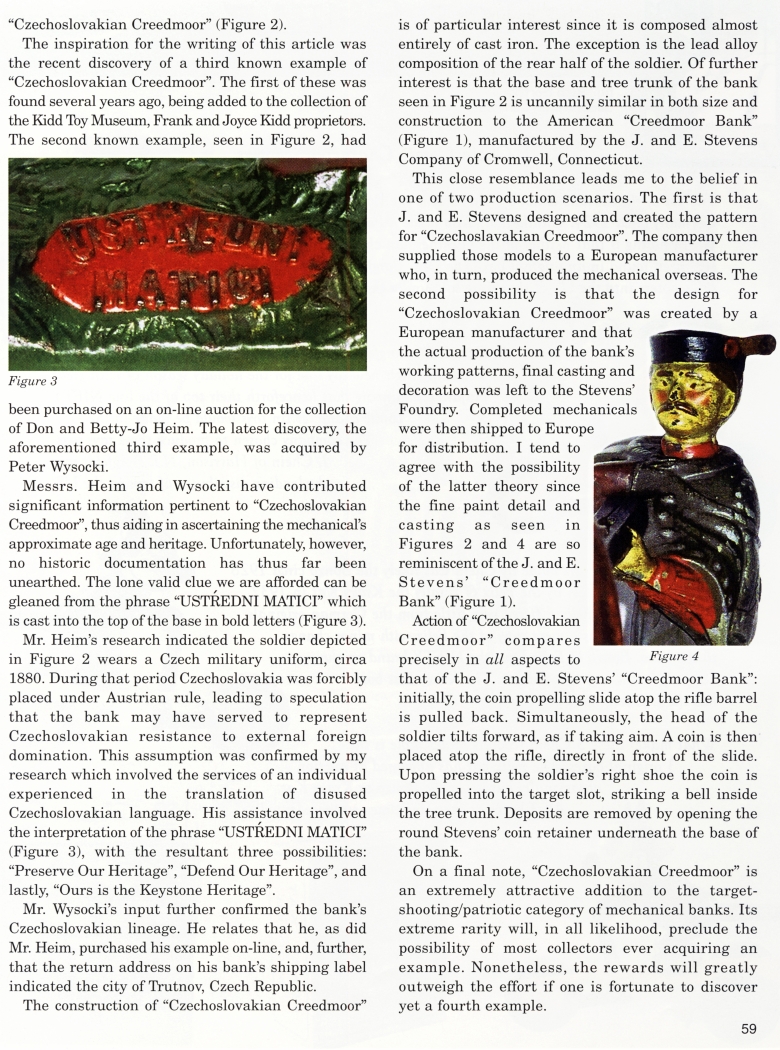|
Czechoslovakian Creedmoor
"Ustŕedini Matici"
by Sy Schreckinger – ANTIQUE TOY WORLD Magazine – August, 2010
PATRIOTISM AND marksmanship have long been popular subjects for
manufacturers of mechanical
banks, both in the United States and abroad. One such example is the
well-known "Creedmoor Bank" (Figure 1). which was inspired by the first
target shooting event organized in this country in the year 1875.
Held at Creedmoor Plains, Long Island, New York, the contest featured
the United States competing against Europe, with the Americans
consistently capturing all medals. Although waning interest in the
yearly competition prompted its discontinuance, heightened enthusiasm
for the sport itself eventually resulted in its becoming a worldwide
pastime.
In addition to the aforementioned
"Creedmoor Bank" (Figure 1), other notable examples of mechanical banks
produced within the late 19th and early 20th centuries depicting the
themes of patriotism and target shooting include "German Marksman Bank",
"Grenadier Bank", "Tommy Bank", "Viennese Soldier", "Volunteer Bank",
"Wimbledon Bank", and the subject of this article,
"Czechoslovakian Creedmoor" (Figure 2).
The inspiration for the writing of this article was the recent discovery
of a third known example of "Czechoslovakian Creedmoor". The first of
these was found several years ago, being added to the collection of the
Kidd Toy Museum, Frank and Joyce Kidd proprietors. The second known
example, seen in Figure 2, had
been purchased on an on-line auction for the collection of Don and
Betty-Jo Heim. The latest discovery, the aforementioned third example,
was acquired by Peter Wysocki.
Messrs. Heim and Wysocki have contributed significant information
pertinent to "Czechoslovakian Creedmoor", thus aiding in ascertaining
the mechanical's approximate age and heritage. Unfortunately, however,
no historic documentation has thus far been unearthed. The lone valid
clue we are afforded can be gleaned from the phrase "USTREDNI MATICI"
which is cast into the top of the base in bold letters (Figure 3).
Mr. Heim's research indicated the soldier depicted in Figure 2 wears a
Czech military uniform, circa 1880. During that period Czechoslovakia
was forcibly placed under Austrian rule, leading to speculation that the
bank may have served to represent Czechoslovakian resistance to external
foreign domination. This assumption was confirmed by my research which
involved the services of an individual experienced in the translation of
disused Czechoslovakian language. His assistance involved the
interpretation of the phrase "USTREDNI MATICI" (Figure 3), with the
resultant three possibilities: "Preserve Our Heritage", "Defend Our
Heritage", and lastly, "Ours is the Keystone Heritage".
Mr. Wysocki's input further confirmed the bank's Czechoslovakian
lineage. He relates that he, as did Mr. Heim, purchased his example
on-line, and, further, that the return address on his bank's shipping
label indicated the city of Trutnov, Czech Republic.
The construction of "Czechoslovakian Creedmoor" is of particular
interest since it is composed almost entirely of cast iron. The
exception is the lead alloy composition of the rear half of the soldier.
Of further interest is that the base and tree trunk of the bank seen in
Figure 2 is uncannily similar in both size and construction to the
American "Creedmoor Bank" (Figure 1), manufactured by the J. and E.
Stevens Company of Cromwell, Connecticut.
This close resemblance leads me to the belief in one of two production
scenarios. The first is that J. and E. Stevens designed and created the
pattern for "Czechoslavakian Creedmoor". The company then supplied those
models to a European manufacturer who, in turn, produced the mechanical
overseas. The second possibility is that the design for "Czechoslovakian
Creedmoor" was created by a European manufacturer and that the actual
production of the bank's working patterns, final casting and decoration
was left to the Stevens' Foundry. Completed mechanicals were then
shipped to Europe
for distribution. I tend to agree with the possibility of the latter
theory since the fine paint detail and casting as seen in Figures 2 and
4 are so reminiscent of the J. and E. Stevens' "Creedmoor Bank" (Figure
1).
Action of "Czechoslovakian Creedmoor" compares precisely in all aspects
to Figure 4
that of the J. and E. Stevens' "Creedmoor Bank": initially, the coin
propelling slide atop the rifle barrel is pulled back. Simultaneously,
the head of the soldier tilts forward, as if taking aim. A coin is then
placed atop the rifle, directly in front of the slide. Upon pressing the
soldier's right shoe the coin is propelled into the target slot,
striking a bell inside the tree trunk. Deposits are removed by opening
the round Stevens' coin retainer underneath the base of the bank.
On a final note, "Czechoslovakian Creedmoor" is an extremely attractive
addition to the target-shooting/patriotic category of mechanical banks.
Its extreme rarity will, in all likelihood, preclude the possibility of
most collectors ever acquiring an example. Nonetheless, the rewards will
greatly outweigh the effort if one is fortunate to discover yet a fourth
example.
|

